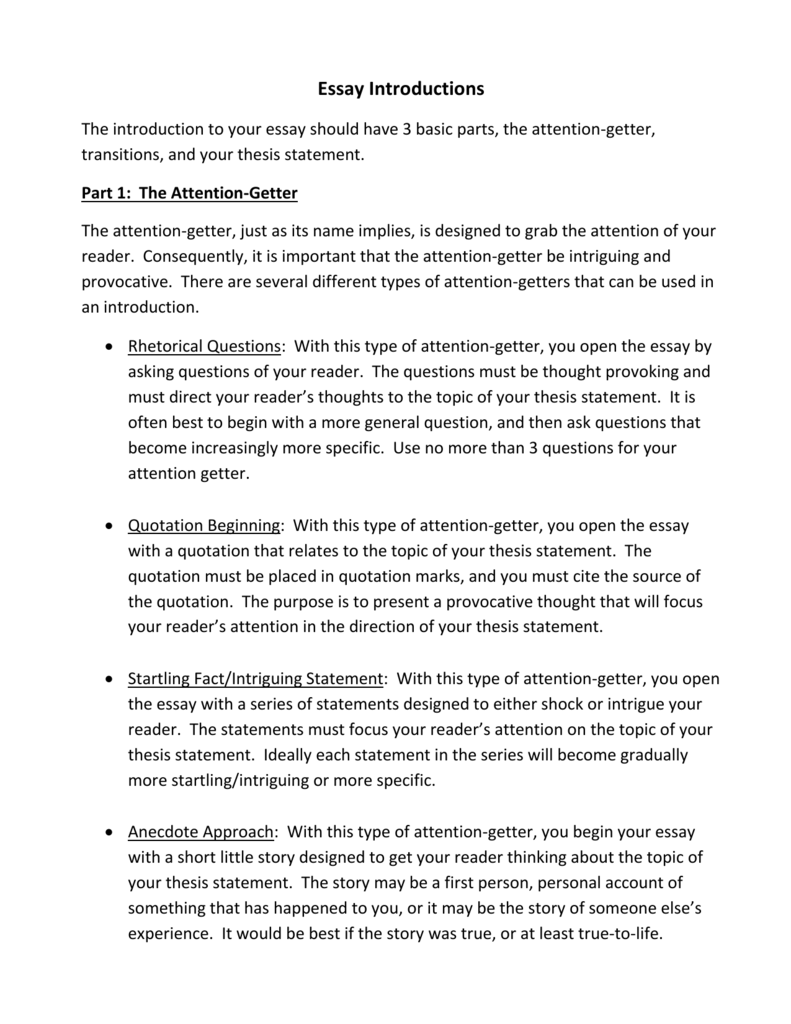
Your introduction is where you will explain why you chose the topic and how you came up with the conclusion. It is essentially a condensed version of your essay, but with little mention of what really went on. That part is discussed in the body. As for your results, you may mention the final verdict, but the conclusion can elaborate on that more Essay introduction is your roadmap for the entire essay. It is a beginning paragraph that sets tone and path for the entire paper you are going to present to your reader. A good introduction to essay catches attention and makes your reader engaged right from the very start. Enough talking about essay introduction definition for now · How to write an essay introduction Step 1: Hook your reader. Your first sentence sets the tone for the whole essay, so spend some time on writing an Step 2: Give background information. Next, give your reader the context they need to understand your
How to Write an Essay Introduction: Structure, Tips | EssayPro
Last Updated: December 16, References Approved. This essay introduction was co-authored by Jake Adams. With over 11 years of professional tutoring experience, Jake is also the CEO of Simplifi EDU, an online tutoring service aimed at providing clients with access to a network of excellent California-based tutors. Jake holds a BA in International Business and Marketing from Pepperdine University. There are 9 references cited in this article, which can be found at the essay introduction of the page.
wikiHow marks an article as reader-approved once it receives enough positive feedback, essay introduction.
This article has been viewed 4, times. The introduction of your essay serves two important purposes. First, it gets your reader interested in the topic and encourages them to essay introduction what you have to say about it. Essay introduction, it gives your reader a roadmap of what you're going to say and the overarching point you're going to make — your thesis statement.
A powerful introduction grabs your reader's attention and keeps them reading. Start your introduction with a relevant story, fact, or quote that will engage readers. Then, add sentences of background information to give your essay context, and include important dates, essay introduction, locations, or historical moments where applicable.
Finally, include your thesis statement, which is a specific, arguable, and provable statement that answers a question about your essay topic. For example, your thesis might read: "In the modern age, online dating apps essay introduction Tinder provide a wider variety of romantic options than young people have ever had before.
Did this summary help you? Yes No. Log in Social login does not work in incognito and private browsers. Please log in with your username or email to continue. wikiHow Account. No account yet? Create an account, essay introduction. Community Dashboard Write an Article Request a New Article More Ideas Edit this Article. Courses New Tech Help New Expert Videos About wikiHow Pro Upgrade Sign In. Home Random Browse Articles Courses New About wikiHow Easy Ways to Help Approve Questions Fix Spelling Quiz App More Things to Try We use cookies to make wikiHow great.
By using our site, essay introduction, you agree to our cookie policy. Cookie Settings. wikiHow is where trusted research and expert knowledge come together. Learn why people trust wikiHow. Categories Education and Communications College University and Postgraduate Academic Writing Essays Essay Introductions How to Write an Essay Introduction. Download Article Explore this Article parts, essay introduction. Tips essay introduction Warnings, essay introduction.
Related Articles, essay introduction. Article Essay introduction. Co-authored by Jake Adams Last Updated: December 16, essay introduction, References Approved. Support wikiHow and unlock all samples.
Narrative Essay Introduction. Expository Essay Introduction. Persuasive Essay Introduction. Part 1 of Identify your audience. The first sentence or two of your introduction should pull the reader in. You want anyone reading your essay to be fascinated, intrigued, or even outraged. You can't do this if you don't know who your likely readers are, essay introduction. If you write directly to your instructor, essay introduction, you'll end up glossing over some information that is necessary to show that you properly understand the subject of your essay.
It can be helpful to reverse-engineer your audience based on the subject matter of your essay, essay introduction. For example, if you're writing an essay about a women's health issue for a women's studies class, you might identify your audience as young women within the age range most affected by the issue. Use the element of surprise. A startling or shocking statistic can grab your audience's attention by immediately teaching them something they didn't know.
Having learned something new in the first sentence, people will essay introduction interested to see where you go next. If you're not sure, test it on a few friends. If they react by expressing shock or surprise, essay introduction know you've got something good. Use a fact or statistic that sets up your essay, not something you'll be using as evidence to prove your thesis statement.
Facts or statistics that demonstrate why your topic is important or should be important to your audience typically make good hooks. Tug at your reader's heart-strings. Particularly with personal or political essays, use your hook to get your reader emotionally involved in the subject matter of your story.
You can do this by describing a related hardship or tragedy. Offer a relevant example or anecdote. In your reading and research for your essay, you may have come across an entertaining or interesting anecdote that, while related, didn't really fit into the body of your essay. Such an anecdote can work great as a hook. For example, if you're writing an essay about a public figure, essay introduction, you might include an anecdote about an odd personal habit that cleverly relates back to your thesis statement.
Particularly with less formal papers or personal essays, humorous anecdotes can be particularly effective hooks. Ask a thought-provoking question. If you're writing a persuasive essay, essay introduction, consider using a relevant question to draw your reader in and get them actively thinking about the subject essay introduction your essay. That's exactly what the essay introduction of the tiny island nation of Guam tried to answer.
Make sure to come up with your own intriguing question. Avoid clichés and generalizations. Generalizations and clichés, essay introduction, even if essay introduction to contrast with your point, won't help your essay. In most cases, they'll actually hurt by making you look like an unoriginal or lazy writer. Broad, sweeping generalizations may ring false with some readers and alienate them from the start.
For example, essay introduction, "everyone wants someone to love" would alienate someone who identified as aromantic or asexual. Part 2 of Relate your hook to a larger topic. The next part of your introduction explains to your reader how that hook connects to the rest of your essay. Start with a broader, more general scope to explain your hook's relevance. For example, if you related a story about one individual, but your essay isn't about them, you can relate the hook back to the larger topic with a sentence like "Tommy wasn't alone, however.
There were more thandockworkers affected by that union strike. Provide necessary background information.
While you're still keeping things essay introduction general, let your readers know anything that will be necessary for them to understand your main argument and the points you're making in your essay.
If you are writing an argumentative paper, make sure to explain both sides of the argument in a neutral or objective manner. Define key terms for the purposes of your essay introduction. Your topic may include broad concepts or terms of art that you will need to define for your reader.
Your introduction isn't the place to reiterate basic dictionary definitions. However, if there is a key term that may essay introduction interpreted differently depending on the context, let your readers know how you're using that term.
Definitions also come in handy in legal or political essays, where a term may have different meanings depending on the context in which they are used, essay introduction. Move from the general to the specific. It can be helpful to think of your introduction as an upside-down pyramid. With your hook sitting on top, your introduction welcomes your readers to the broader world in which your thesis essay introduction. Draw your reader in gradually.
For example, if you're writing an essay introduction about drunk driving fatalities, you might start with an anecdote about a particular victim. Then you could provide national statistics, then narrow it down further to statistics for a particular gender or age group.
Part 3 of Make your point. After you've set up the context within which you're making your argument, tell your readers the point of your essay.
Use your thesis statement to directly communicate the unique point you will attempt to make through your essay. Avoid including fluff such as "In this essay, I will attempt to show Your outline should be specific, unique, and provable.
IELTS / TOEFL Essay: introduction paragraph as 1st impression
, time: 7:41How to Write an Essay Introduction | 4 Steps & Examples

Essay introduction is your roadmap for the entire essay. It is a beginning paragraph that sets tone and path for the entire paper you are going to present to your reader. A good introduction to essay catches attention and makes your reader engaged right from the very start. Enough talking about essay introduction definition for now · How to write an essay introduction Step 1: Hook your reader. Your first sentence sets the tone for the whole essay, so spend some time on writing an Step 2: Give background information. Next, give your reader the context they need to understand your Your introduction is where you will explain why you chose the topic and how you came up with the conclusion. It is essentially a condensed version of your essay, but with little mention of what really went on. That part is discussed in the body. As for your results, you may mention the final verdict, but the conclusion can elaborate on that more

No comments:
Post a Comment